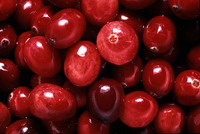Appetite for cranberries grows overseas
Sales of cranberries go up overseas, because this berry has been a staple in American diets since long before the Pilgrims arrived at Plymouth Rock.

So much so that Cheryl Urban of Wisconsin Rapids, a cranberry grower who also processes the crops of six other growers, said 30 percent of her firm's sales will go to foreign markets this year. In 2001, she had no cranberry sales overseas.
"It was just a matter of getting the message out about cranberries," she said. "It's becoming a staple for them just as it is for us."
The message is for a product that is tasty, healthy and versatile, growers say, as it shows up in everything from soap to nut breads.
The national Cranberry Marketing Committee began promoting the product outside the country in earnest in 1999, said Michael Rucier of Seattle, the committee's export promotion manager. Foreign sales were 14 percent of the market that year at nearly 898,000 barrels. That increased to 27 percent of the market last year with more than 1.67 million barrels shipped overseas.
The largest producer, Ocean Spray Cranberries Inc., has seen its foreign business grow by double-digit percentages each year for more than a decade and is now $300 million (212 million EUR) to $400 million (282 million EUR) annually in 80 different countries, said company chief executive officer Randy Papadellis.
The Cranberry Marketing Committee was created in 1962 to maintain a balance between supply and demand in the U.S. cranberry industry. It was amended in 1992 to allow the committee to promote the sale of and use of cranberries and cranberry products.
"The bottom fell out of the market" in 1999, and cranberry prices plummeted, Rucier said. "We had a lot of inventory and no place to sell it."
Cranberry sales have grown substantially since then, especially in the United Kingdom, Germany, Australia, France, South Korea, Mexico, Japan, the Netherlands, Spain, Austria and Switzerland, he said.
Wisconsin, the top cranberry-producing state in the U.S., expects to harvest 3.9 million barrels of the tart fruit this year, more than half the crop produced nationwide. That's followed by Massachusetts at 1.8 million, New Jersey at 520,000, Oregon at 500,000 and the state of Washington at 180,000.
The cranberry is one of only three fruits native to North America, along with blueberries and concord grapes.
Generic marketing of cranberries overseas by the Cranberry Marketing Committee is financed primarily through assessments collected by the committee from growers on each barrel produced and through grants provided by the U.S. Department of Agriculture, Rucier said.
That spending has increased from nearly $275,000 in 1999 to more than $1.6 million this year, Rucier said.
Individual firms also promote their own brands. Ocean Spray, which provides 70 percent of the world's cranberries, spends $45 million (32 million EUR) a year on television advertising alone, with about one-third of that going overseas, Papadellis said.
Ocean Spray spokesman Chris Phillips said the producer was optimistic its foreign sales would within a few years reach the level that Ocean Spray's overall sales are now.
The USDA's National Agriculture Statistics Service forecast in August that the 2007 U.S. cranberry crop would be 6.9 million barrels, just 1,000 more than last year, but up 11 percent from 2005.
That compares with nearly 3.4 million barrels in 1990, and more than 5.7 million in 2000, the agency said.
Subscribe to Pravda.Ru Telegram channel, Facebook, RSS!




